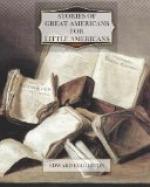There was some wet ground at the back of Smith’s garden. In this wet ground he sowed some of the rice. It grew finely.
He gathered a good deal of rice in his garden that year. He gave part of this to his friends. They all sowed it. The next year there was a great deal of rice.
After a while the wet land in South Car-o-li-na was turned to rice fields. Every year many thousands of barrels of rice were sent away to be sold.
All this came from one little bag of rice and one wise man.
[Illustration: Rice Plant.]
THE STORY OF A WISE WOMAN.
You have read how Thomas Smith first raised rice in Car-o-li-na. After his death there lived in South Car-o-li-na a wise young woman. She showed the people how to raise another plant. Her name was Eliza Lucas.
The father of Miss Lucas did not live in Car-o-li-na. He was gov-ern-or of one of the islands of the West Indies. Miss Lucas was fond of trying new things. She often got seeds from her father. These she planted in South Carolina.
Her father sent her some seeds of the in-di-go plant. She sowed some of these in March. But there came a frost. The in-di-go plant cannot stand frost. Her plants all died.
But Miss Lucas did not give up. She sowed some more seeds in April. These grew very well until a cut-worm found them. The worm wished to try new things, too. So he ate off the in-di-go plants.
But Miss Lucas was one of the people who try, try again. She had lost her indigo plants twice. Once more she sowed some of the seed. This time the plants grew very well.
Miss Lucas wrote to her father about it. He sent her a man who knew how to get the indigo out of the plant.
The man tried not to show Miss Lucas how to make the indigo. He did not wish the people in South Carolina to learn how to make it. He was afraid his own people would not get so much for their indigo.
So he would not explain just how it ought to be done. He spoiled the indigo on purpose.
But Miss Lucas watched him closely. She found out how the indigo ought to be made. Some of her father’s land in South Carolina was now planted with the indigo plants.
[Illustration: Indigo Plant.]
Then Miss Lucas was married. She became Mrs. Pinck-ney. Her father gave her all the indigo growing on his land in South Carolina. It was all saved for seed. Some of the seed Mrs. Pinck-ney gave to her friends. Some of it her husband sowed. It all grew, and was made into that blue dye that we call indigo. When it is used in washing clothes, it is called bluing.
In a few years, more than a million pounds of indigo were made in South Carolina every year. Many people got rich by it. And it was all because Miss Lucas did not give up.




